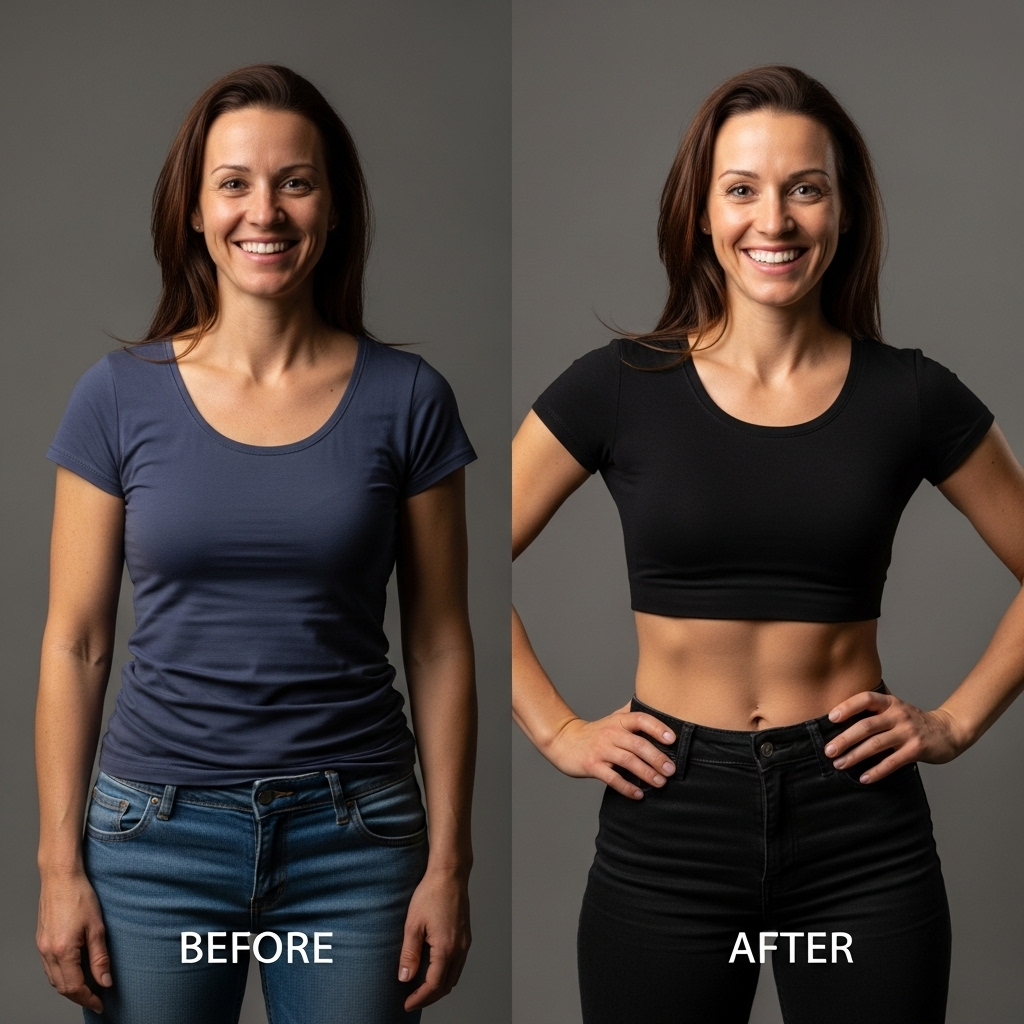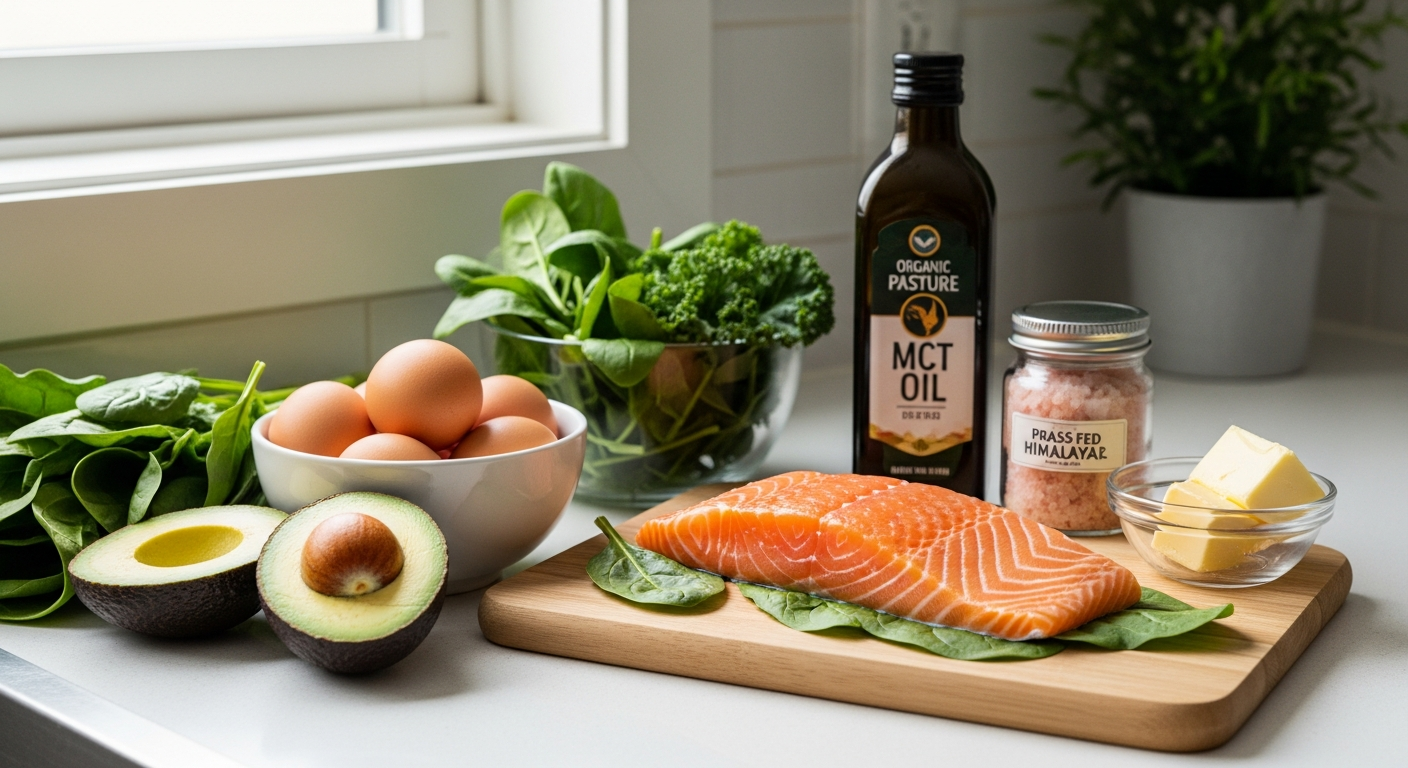I’m going to be honest with you - waiting 3-4 days to get into ketosis sucks.
The brain fog. The fatigue. The constant hunger. The wondering if this whole keto thing is actually working or if you’re just torturing yourself for no reason.
I’ve done the slow transition. I’ve also done the fast-track protocol I’m about to show you. And while the fast approach isn’t exactly comfortable, it beats the hell out of dragging the misery out for a week.
Here’s how to get into ketosis in 24-72 hours instead of 3-7 days.
24-Hour Ketosis Protocol Summary
Restrict carbs to under 20g net. Fast for 16-24 hours (water, black coffee, bone broth only). Add 1-2 tbsp MCT oil when breaking fast. Do 30-45 minutes of light exercise while fasted. Load up on electrolytes (5g sodium, potassium, magnesium). Keep protein moderate (70-100g). Most people enter measurable ketosis within 24-48 hours.
What is Ketosis?
Ketosis is a metabolic state where your body shifts from using glucose (carbs) as its primary fuel to burning fat and producing ketone bodies in your liver - specifically beta-hydroxybutyrate (BHB).
When you’re in ketosis, your metabolism is primed for fat-burning instead of sugar-burning.
Here’s what actually happens: your liver breaks down fat (both from food and stored body fat) into ketones. Your brain and muscles can use these ketones for energy instead of glucose. It’s like switching your body’s fuel source from gasoline to diesel - same engine, different fuel.
I remember the first time I tested positive for ketosis (those urine strips turning purple). It was like unlocking a metabolic superpower I didn’t know existed. My hunger disappeared. My energy stabilized. My brain fog cleared.
But getting there? That’s the hard part.
Why Getting into Ketosis Quickly Matters
Listen, there are two ways to start keto: the slow crawl or the fast jump. I’ve done both.
The slow method means you spend 4-7 days in this awful metabolic limbo where you’re low on glucose but not yet running efficiently on ketones. That’s when you feel like absolute garbage - tired, foggy, hungry, irritable.
Here’s why speed matters:
Faster transition = less suffering. The quicker you get into ketosis, the less time you spend feeling like death. Simple math.
You start getting benefits sooner. Better energy, fat burning, appetite control, mental clarity - all the good stuff kicks in when you’re actually in ketosis, not limping toward it.
Momentum builds. When you see results quickly (ketone test strips turning purple, energy coming back, hunger dropping), you’re way more likely to stick with it. Nothing kills motivation like a week of misery with no visible progress.
Perfect for resets. If you fell off the wagon after a carb binge or vacation, the fast protocol gets you back into ketosis without dragging it out.
I use this protocol every time I need to get back into ketosis after traveling or holidays. It works.
How Long Does It Typically Take?
Most sources say standard keto triggers ketosis in about 2-4 days for most people. That’s if you’re eating under 20g net carbs daily and just waiting for your body to naturally burn through its glycogen stores.
But with an aggressive, targeted protocol? You can enter detectable ketosis in 24 hours, and more reliably by 48-72 hours.
It depends on several factors:
- Your metabolism - some people just adapt faster
- Glycogen reserves - if you’ve been carb-loading, you have more to burn through
- Activity level - exercise depletes glycogen faster
- Prior diet - if you’ve done keto before, your body remembers and adapts quicker
The first time I tried keto, it took me almost 4 days to test positive. The second time (using this protocol), I was in ketosis by day 2. Your body learns.
For beginners starting from a high-carb diet, expect closer to 48-72 hours. For keto veterans or people coming from lower-carb diets, 24-36 hours is totally doable.
The 24-Hour Kickstart Protocol
Alright, here’s the streamlined version - the exact protocol I use when I need to get into ketosis fast.
Carb intake: 20g net carbs or lower immediately
Not 30g. Not 50g. Twenty grams or less. This is non-negotiable if you want speed. Track every single thing you eat for the first few days.
Fasting window: 16-24 hours
Water, black coffee, tea, and bone broth only. No calories, no sweeteners, nothing that spikes insulin. This accelerates glycogen depletion like nothing else.
I usually do dinner the night before, then skip breakfast and lunch the next day. That’s an easy 16-18 hour fast without too much suffering.
Healthy fats in your eating window
When you break your fast, include MCT oil or coconut oil. These convert to ketones rapidly and give you a metabolic boost.
Light exercise while fasted
A moderately intense session (30-45 minutes) helps burn remaining glycogen stores. I’m talking brisk walk, bodyweight circuits, light jog - not trying to set PRs.
Electrolytes and hydration
Increase sodium (3-5g daily), potassium, and magnesium. This is crucial to avoid keto flu symptoms and support adaptation.
Moderate protein
Don’t overconsume protein - excess converts to glucose via gluconeogenesis and slows ketosis entry. Keep it around 70-100g daily depending on your size.
If you nail these six things, you’ll be in ketosis faster than the standard approach. Guaranteed.
Detailed Step-by-Step: What to Eat, Drink & Do
Let me walk you through exactly what I do, hour by hour.
Day 0 (Evening before start)
Dinner: Light, low-carb meal
I keep it simple: grilled wild-caught salmon with a big salad (spinach, olive oil, lemon), half an avocado, and some leafy greens sautéed in butter.
No starches. No sugary foods. No alcohol.
Add extra salt to your meal - you’re about to lose a lot of water and sodium.
Drink 16-20oz of water before bed.
Prep your kitchen
Remove temptations. Stock up on essentials: eggs, avocados, fatty fish, olive oil, butter, bone broth, MCT oil, sea salt, magnesium supplement.
Set yourself up for success.
Day 1 (Kickstart day)
Morning (upon waking)
Do NOT eat breakfast. You’re fasting.
Drink 16oz water with a pinch of sea salt (sounds gross, tastes like ocean water, works like magic for electrolytes).
Black coffee or green tea if you want. No cream, no sweeteners - just straight caffeine and water.
Take your magnesium supplement now.
Mid-morning (9-11am) - Exercise

This is when I do my fasted workout. Nothing crazy - just enough to burn through remaining glycogen:
- 30-45 minute brisk walk
- Bodyweight circuit (push-ups, squats, burpees, planks)
- Light jog or bike ride
- HIIT session if you’re already fit (but keep it moderate)
You’ll feel depleted. That’s the point. You’re running on fumes and forcing your body to switch fuel sources.
Stay hydrated during exercise. I bring a water bottle with a pinch of salt.
Midday (12-2pm)
Still fasting. Drink bone broth or bouillon if you’re feeling weak - the sodium helps tremendously.
You’ll probably be hungry. That’s normal. Hunger doesn’t mean you’re dying - it means your body is switching from glucose to fat burning.
I keep busy during this time. Work, errands, anything to keep my mind off food.
Afternoon (2-4pm) - Breaking the fast
This is when you eat. You’ve been fasting 16-20 hours at this point.
First meal (my exact go-to):
- 2-3 eggs scrambled in butter or ghee
- Half to full avocado
- Handful of spinach sautéed in olive oil
- 1 tablespoon MCT oil mixed into black coffee or taken straight (warning: start with 1 tbsp to avoid digestive issues - MCT oil can cause stomach upset if you’re not used to it)
- Extra sea salt on everything
Keep protein moderate this meal (20-30g max). Too much protein can convert to glucose and slow things down.
Total carbs: under 5g
MCT Oil Explained
Medium-chain triglycerides (MCTs) bypass normal fat digestion and go straight to your liver where they’re converted to ketones quickly. This gives you a ketone boost even before you’re fully fat-adapted. Start with 1 tbsp and work up to 2-3 tbsp over a few days to avoid stomach issues.
Evening (6-8pm)
Light dinner, same principles:
- Fatty fish (salmon, mackerel) or ribeye steak
- Olive oil or butter on vegetables (broccoli, asparagus, zucchini)
- Another half avocado or handful of macadamia nuts
- Bone broth on the side
- Keep total carbs under 10g net for the day
Drink more water. Add salt. Take your evening magnesium.
Go to bed early (9-10pm if possible). Your body adapts faster when you sleep.
Day 2 (If still adapting)
Continue eating under 20g net carbs. Eat primarily fat, moderate protein (70-100g total daily), and stay hydrated.
Monitor how you feel:
- Energy levels returning?
- Mental clarity improving?
- Hunger decreasing?
- Breath smelling fruity/metallic? (acetone breath is a sign of ketosis)
Optional: Take exogenous ketones (BHB salts or esters) if you want to boost blood ketone levels faster. They don’t replace fat adaptation, but they help bridge the gap.
Test ketones with a blood meter, breath analyzer, or urine strips (blood is most accurate).
By end of day 2 or day 3, you should be in measurable ketosis.
Quick Tip
Make “keto-ade” to crush electrolyte needs: 16oz water + 1/4 tsp sea salt + 1/4 tsp lite salt (potassium) + squeeze of lemon. Drink 2-3 times daily to prevent keto flu symptoms.
Accelerators & Supplements (Optional)
These aren’t mandatory, but they help.
MCT oil / coconut oil
I already mentioned this, but it’s worth repeating. MCT oil converts to ketones rapidly - way faster than regular dietary fat.
Start with 1 tablespoon, work up to 2-3 tablespoons daily over a week. Take it with food to avoid digestive upset.
I mix mine into black coffee (bulletproof coffee style) or drizzle it on salads.
Exogenous ketones (BHB salts/esters)
These raise blood ketone levels temporarily - useful if you need a mental boost during adaptation or want confirmation that ketosis “feels like.”
They don’t replace fat adaptation. You’re still teaching your body to produce its own ketones efficiently. But exogenous ketones help in the meantime.
Fair warning: they taste absolutely terrible. Like drinking ocean water mixed with artificial sweetener. Chase with water.
Ketone testing
Not mandatory, but incredibly motivating.
Blood ketone meter (most accurate): Measures 0.5-3.0 mmol/L range. You’re in nutritional ketosis at 0.5+ mmol/L. I aim for 1.0-2.0 mmol/L.
Breath ketone analyzer (decent accuracy, reusable): Detects acetone in your breath. No strips needed.
Urine ketone strips (cheap, less accurate once adapted): Good for confirming initial ketosis. After a few weeks, your body stops “wasting” ketones in urine, so strips become unreliable.
I use a blood meter. Seeing 1.5 mmol/L on day 2 is hugely motivating.
Electrolyte supplements
This is non-negotiable if you want to avoid feeling like death.
- Magnesium citrate or glycinate: 300-400mg daily (helps with sleep, muscle cramps, energy)
- Potassium: Get from food (avocado, spinach, salmon) or use lite salt (half sodium, half potassium)
- Sodium: 3-5g daily from sea salt and bone broth (way more than standard recommendations - low insulin on keto causes kidneys to dump sodium)
I take magnesium before bed, salt everything I eat, and drink bone broth twice daily.
Common Mistakes & How to Avoid Them
I’ve screwed up every single one of these. Learn from my mistakes.
Eating too many hidden carbs
Packaged “low-carb” foods, sauces, dressings, sugar alcohols (maltitol is the worst), ketchup - they all add up fast.
Track everything using Cronometer or MyFitnessPal for the first week. You’d be shocked how many carbs hide in “keto-friendly” products.
One time I stalled for three days because I didn’t realize my sugar-free BBQ sauce had 8g carbs per serving. Read labels religiously.
Over-consuming protein
This is huge. People cut carbs but eat 150-200g protein daily thinking “protein is good.”
Excess protein converts to glucose via gluconeogenesis and delays ketosis entry. Keep it moderate - around 0.6-0.8g per pound of lean body mass.
For most people, that’s 70-100g daily. More if you’re very active or lifting heavy.
Neglecting electrolytes and hydration
This is why most people feel terrible during transition. Low insulin causes your kidneys to dump sodium and water. If you don’t replace it, you get headaches, fatigue, cramps, brain fog - full-blown keto flu.
Fix it aggressively: salt everything, drink bone broth, take magnesium, hydrate constantly.
I learned this the hard way. Day 3 of my first keto attempt, I had a splitting headache and felt like I had the actual flu. Added salt and bone broth, felt better within 2 hours. Electrolytes matter more than anything else.
Training too hard too soon
Your body is adapting to a completely different fuel system. Heavy lifting or intense cardio during the first 3-5 days will make you feel terrible and slow adaptation.
Stick to light movement - walks, yoga, bodyweight circuits. Save the heavy training for after you’re adapted (week 2+).
I tried to crush a HIIT workout on day 2 of my first keto attempt. Nearly passed out. Don’t be me.
Expecting instant perfection
Getting into ketosis quickly is possible. Feeling amazing instantly? Not so much.
You’ll feel rough days 1-3 even with perfect electrolytes. That’s normal. Your brain and muscles are learning to run on a different fuel. Give it time.
The energy, mental clarity, and appetite suppression kick in around days 4-7 once you’re adapted. Be patient.
Safety Considerations & Who Should Be Careful
Fast ketosis entry is aggressive. It’s generally safe for healthy adults, but certain people need to be cautious or avoid it entirely.
Don’t do this if you have:
- Type 1 diabetes - ketosis can trigger dangerous ketoacidosis without medical supervision
- Type 2 diabetes on insulin or certain medications - consult your doctor first; dosages may need adjustment
- Kidney disease or history of kidney stones - keto increases kidney workload
- Liver disease - your liver produces ketones; if it’s compromised, this could be risky
- History of eating disorders - fasting and restrictive eating can trigger unhealthy patterns
- Pregnancy or breastfeeding - developing babies and milk production need consistent glucose
Keto flu is real but manageable
Expect headache, fatigue, irritability, nausea, muscle cramps during days 1-3. This isn’t dangerous - it’s electrolyte depletion and metabolic adaptation.
Fix it with sodium, potassium, magnesium, and water. Not willpower - actual electrolytes.
If symptoms are severe (persistent vomiting, extreme weakness, heart palpitations, chest pain), stop immediately and consult a doctor.
Rapid water loss
You’ll lose 5-10 pounds the first week. Don’t get too excited - most of it is water weight (glycogen binds to water; when you burn glycogen, you release water).
Real fat loss comes later. The initial drop is motivating but temporary.
I lost 8 pounds my first week. Gained 3 back when I had a carb refeed. It’s just water. Don’t panic.
Final Thoughts & Next Steps
Getting into ketosis in 24 hours is ambitious, but totally achievable for healthy individuals who commit to the protocol: carb restriction (under 20g), fasting (16-24 hours), fat fuel (MCT oil), movement (fasted exercise), and electrolytes (sodium, potassium, magnesium).
At Keto Simplified, I recommend using this 24-hour protocol as a jumpstart, then transitioning to a sustainable daily plan with quality whole foods for long-term success. If you want to understand the quality difference in keto foods, check out clean vs dirty keto.
Once you’re in ketosis, your focus shifts from “just get in” to “stay in and thrive.” That means consistent macros, quality food, adequate sleep, stress management, and support.
Your next steps:
-
Pick your start day. Choose a weekend or low-stress period. Don’t start before a big work presentation or social event.
-
Stock your kitchen. Eggs, avocados, fatty meat, olive oil, butter, leafy greens, bone broth, sea salt, magnesium supplement, MCT oil. Remove carb temptations.
-
Track everything. Use Cronometer or MyFitnessPal to track carbs, protein, fat for at least the first week. Knowledge beats guessing.
-
Test ketones (optional). Blood meter is best. Seeing measurable results is hugely motivating.
-
Fix electrolytes proactively. Don’t wait until you feel terrible. Salt everything, drink bone broth, take magnesium from day one.
-
Be patient with adaptation. You’ll enter ketosis in 24-48 hours, but feeling great takes 4-7 days once you’re fat-adapted. Stick with it through the rough patch.
-
Document your experience. Track how you feel, what you eat, ketone levels, energy. Refine what works for your body.
The 24-hour protocol isn’t magic - it’s just a strategic combination of fasting, carb restriction, exercise, fat loading, and electrolyte management to speed up what would happen naturally over 3-4 days.
Is it harder than the slow approach? Honestly, yes - that first day sucks. But it’s over faster. And for many people (myself included), ripping the band-aid off beats slowly peeling it for a week.
For long-term success and detailed guidance, grab our free keto starter guide or check out our 7-day meal plan.
Now go deplete some glycogen and unlock fat-burning mode.

